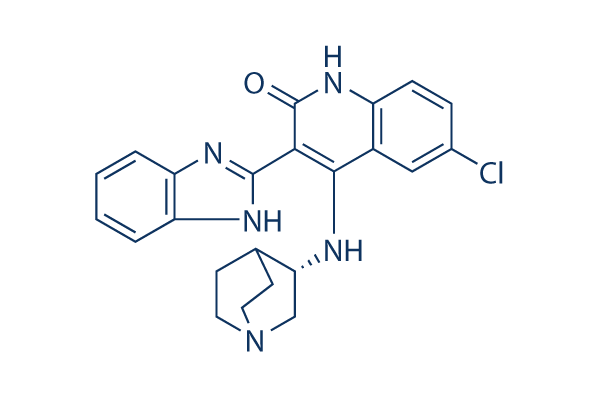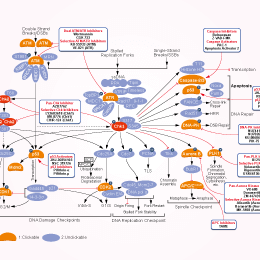
- Bioactive Compounds
- By Signaling Pathways
- PI3K/Akt/mTOR
- Epigenetics
- Methylation
- Immunology & Inflammation
- Protein Tyrosine Kinase
- Angiogenesis
- Apoptosis
- Autophagy
- ER stress & UPR
- JAK/STAT
- MAPK
- Cytoskeletal Signaling
- Cell Cycle
- TGF-beta/Smad
- DNA Damage/DNA Repair
- Compound Libraries
- Popular Compound Libraries
- Customize Library
- Clinical and FDA-approved Related
- Bioactive Compound Libraries
- Inhibitor Related
- Natural Product Related
- Metabolism Related
- Cell Death Related
- By Signaling Pathway
- By Disease
- Anti-infection and Antiviral Related
- Neuronal and Immunology Related
- Fragment and Covalent Related
- FDA-approved Drug Library
- FDA-approved & Passed Phase I Drug Library
- Preclinical/Clinical Compound Library
- Bioactive Compound Library-I
- Bioactive Compound Library-Ⅱ
- Kinase Inhibitor Library
- Express-Pick Library
- Natural Product Library
- Human Endogenous Metabolite Compound Library
- Alkaloid Compound LibraryNew
- Angiogenesis Related compound Library
- Anti-Aging Compound Library
- Anti-alzheimer Disease Compound Library
- Antibiotics compound Library
- Anti-cancer Compound Library
- Anti-cancer Compound Library-Ⅱ
- Anti-cancer Metabolism Compound Library
- Anti-Cardiovascular Disease Compound Library
- Anti-diabetic Compound Library
- Anti-infection Compound Library
- Antioxidant Compound Library
- Anti-parasitic Compound Library
- Antiviral Compound Library
- Apoptosis Compound Library
- Autophagy Compound Library
- Calcium Channel Blocker LibraryNew
- Cambridge Cancer Compound Library
- Carbohydrate Metabolism Compound LibraryNew
- Cell Cycle compound library
- CNS-Penetrant Compound Library
- Covalent Inhibitor Library
- Cytokine Inhibitor LibraryNew
- Cytoskeletal Signaling Pathway Compound Library
- DNA Damage/DNA Repair compound Library
- Drug-like Compound Library
- Endoplasmic Reticulum Stress Compound Library
- Epigenetics Compound Library
- Exosome Secretion Related Compound LibraryNew
- FDA-approved Anticancer Drug LibraryNew
- Ferroptosis Compound Library
- Flavonoid Compound Library
- Fragment Library
- Glutamine Metabolism Compound Library
- Glycolysis Compound Library
- GPCR Compound Library
- Gut Microbial Metabolite Library
- HIF-1 Signaling Pathway Compound Library
- Highly Selective Inhibitor Library
- Histone modification compound library
- HTS Library for Drug Discovery
- Human Hormone Related Compound LibraryNew
- Human Transcription Factor Compound LibraryNew
- Immunology/Inflammation Compound Library
- Inhibitor Library
- Ion Channel Ligand Library
- JAK/STAT compound library
- Lipid Metabolism Compound LibraryNew
- Macrocyclic Compound Library
- MAPK Inhibitor Library
- Medicine Food Homology Compound Library
- Metabolism Compound Library
- Methylation Compound Library
- Mouse Metabolite Compound LibraryNew
- Natural Organic Compound Library
- Neuronal Signaling Compound Library
- NF-κB Signaling Compound Library
- Nucleoside Analogue Library
- Obesity Compound Library
- Oxidative Stress Compound LibraryNew
- Plant Extract Library
- Phenotypic Screening Library
- PI3K/Akt Inhibitor Library
- Protease Inhibitor Library
- Protein-protein Interaction Inhibitor Library
- Pyroptosis Compound Library
- Small Molecule Immuno-Oncology Compound Library
- Mitochondria-Targeted Compound LibraryNew
- Stem Cell Differentiation Compound LibraryNew
- Stem Cell Signaling Compound Library
- Natural Phenol Compound LibraryNew
- Natural Terpenoid Compound LibraryNew
- TGF-beta/Smad compound library
- Traditional Chinese Medicine Library
- Tyrosine Kinase Inhibitor Library
- Ubiquitination Compound Library
-
Cherry Picking
You can personalize your library with chemicals from within Selleck's inventory. Build the right library for your research endeavors by choosing from compounds in all of our available libraries.
Please contact us at [email protected] to customize your library.
You could select:
- Antibodies
- Bioreagents
- qPCR
- 2x SYBR Green qPCR Master Mix
- 2x SYBR Green qPCR Master Mix(Low ROX)
- 2x SYBR Green qPCR Master Mix(High ROX)
- Protein Assay
- Protein A/G Magnetic Beads for IP
- Anti-Flag magnetic beads
- Anti-Flag Affinity Gel
- Anti-Myc magnetic beads
- Anti-HA magnetic beads
- Magnetic Separator
- Poly DYKDDDDK Tag Peptide lyophilized powder
- Protease Inhibitor Cocktail
- Protease Inhibitor Cocktail (EDTA-Free, 100X in DMSO)
- Phosphatase Inhibitor Cocktail (2 Tubes, 100X)
- Cell Biology
- Cell Counting Kit-8 (CCK-8)
- Animal Experiment
- Mouse Direct PCR Kit (For Genotyping)
- New Products
- Contact Us
CHIR-124
CHIR-124 is a novel and potent Chk1 inhibitor with IC50 of 0.3 nM in a cell-free assay. It shows 2,000-fold selectivity against Chk2, 500- to 5,000-fold less activity against CDK2/4 and Cdc2.

CHIR-124 Chemical Structure
CAS No. 405168-58-3
Purity & Quality Control
Batch:
Purity:
99.48%
99.48
CHIR-124 Related Products
| Related Targets | Chk1 Chk2 | Click to Expand |
|---|---|---|
| Related Products | AZD7762 Rabusertib (LY2603618) MK-8776 (SCH 900776) Prexasertib HCl (LY2606368) PF-477736 BML-277 (Chk2 Inhibitor II) Prexasertib (LY2606368) CCT245737 (SRA737) GDC-0575 | Click to Expand |
| Related Compound Libraries | Kinase Inhibitor Library PI3K/Akt Inhibitor Library MAPK Inhibitor Library DNA Damage/DNA Repair compound Library Cell Cycle compound library | Click to Expand |
Signaling Pathway
Cell Data
| Cell Lines | Assay Type | Concentration | Incubation Time | Formulation | Activity Description | PMID |
|---|---|---|---|---|---|---|
| human MDA-MB-435 cells | Cytotoxic assay | Cytotoxicity against human MDA-MB-435 cells, EC50=0.08 μM | 16603354 | |||
| human MDA-MB-435 cells | Cytotoxic assay | Cytotoxicity against human MDA-MB-435 cells in presence of camptothecin | 16603354 | |||
| Click to View More Cell Line Experimental Data | ||||||
Biological Activity
| Description | CHIR-124 is a novel and potent Chk1 inhibitor with IC50 of 0.3 nM in a cell-free assay. It shows 2,000-fold selectivity against Chk2, 500- to 5,000-fold less activity against CDK2/4 and Cdc2. | ||||||||
|---|---|---|---|---|---|---|---|---|---|
| Targets |
|
| In vitro | ||||
| In vitro | CHIR-124 is a quinolone-based small molecule that is structurally unrelated to other known inhibitors of Chk1. CHIR-124 interacts synergistically with topoisomerase poisons (e.g., Camptothecin or SN-38) in causing growth inhibition in a variety of cancer cell lines, including breast carcinoma (MDA-MB-231 and MDA-MB-435) and colon carcinoma (SW-620 and Colo205), all of which contains the mutant p53 gene. CHIR-124 abrogates the SN-38-induced S and G2-M checkpoints and potentiates apoptosis in MDA-MD-435 breast cancer cells. The abrogation of the G2-Mcheckpoint and induction of apoptosis by CHIR-124 are enhanced by the loss of p53. [1] CHIR-124 also potently targets other kinases such as PDGFR and Flt3 with IC50 of 6.6 nM and 5.8 nM, respectively. [2] |
|||
|---|---|---|---|---|
| Kinase Assay | Chk1 Assay | |||
| For the Chk1 assay, the kinase domain is expressed in Sf9 insect cells, and a biotinylated cdc25c peptide containing the consensus Chk1/Chk2 phosphorylation site (*)(biotin-[AHX]SGSGS*GLYRSPSMP-ENLNRPR[CONH2]) is used as the substrate. A dilution series of CHIR-124 is mixed with a kinasereaction buffer containing a final concentration of 30 mM Tris-HCl(pH 7.5), 10 mM MgCl2, 2 mM DTT, 4 mM EDTA, 25 mMβ-glycerophosphate, 5 mM MnCl2, 0.01% bovine serum albumin, 1.35 nM CHK1 kinase domain, 0.5 μM peptide substrate, and 1 AM unlabeled ATP, plus 5 nM 33Pγ-labeled ATP (specific activity = 2,000 Ci/mmol). Reactions and detection of the phosphate transfer are carried out by a radioactive method. Reactions are incubated at room temperature for 1 to 4 hours and the phosphorylated peptide captured on streptavidin-coated microtiter plates containing stop reaction buffer (25 mM EDTA [ethylenediaminetetraacetic acid], 50 mMHEPES, pH 7.5). Phosphorylated peptide is measured with the DELFIA TRF system using a Europium-labeled anti-phosphotyrosine antibody PT66. The concentration of CHIR-124 for IC50 is calculated using nonlinear regression with XL-Fit data analysis software. | ||||
| Cell Research | Cell lines | MDA-MB-231, MDA-MB-435, SW-620, and COLO 205 cells | ||
| Concentrations | 0-2350 nM, dependent on cell types | |||
| Incubation Time | 48 hours | |||
| Method | MDA-MB-231, MDA-MB-435, SW-620, and COLO 205 cells in log-phase are plated into 96-well microplates. CHIR-124 is serially diluted in the presence of six different concentrations of Camptothecin or 0 nM camptothecin. Camptothecin is also serially diluted in the absence of CHIR-124. CHIR-124 is added to cells in 96-well dishes and incubated at 37 °C for 48 hours. Each treatment condition is done in triplicate. Cell proliferation is monitored by the 3-(4,5-dimethylthiazol-2-yl)-5- (3-carboxymethoxyphenyl)-2-(4-sulfophenyl)-2H-tetrazolium (MTS), inner salt assay. MTS inner salt is added to the microplates, which are incubated for another 3 hours, and absorbance at 490 nm is read on a plate reader. The concentrations of each drug in the combinations required to produce 50% inhibition are plotted to generate the isoboles. Isobologram analysis of drug interaction is based the equation of Loewe additivity (1= D A /IC50, A + DB/IC50, B), where IC50, A and IC50, B are the concentrations of drugs to result in 50% inhibition for each drug alone, and DA and DB are concentrations of each drug in the combination that yield 50% overall inhibition. A diagonal line indicating Loewe additivity is included in each graph. Data points that fall below the line indicate synergy, whereas those that fall above the line will indicate antagonism |
|||
| In Vivo | ||
| In vivo | CHIR-124 potentiates the growth inhibitory effects by abrogating the G2-M checkpoint and increasing tumor apoptosis in an orthotopic breast cancer xenograft model. |
|
|---|---|---|
| Animal Research | Animal Models | MDA-MB-435 cells are implanted in the mammary fat pad of 8- to 10-week-old female immunodeficient mice. |
| Dosages | 10 mg/kg or 20 mg/kg | |
| Administration | CHIR-124 is given orally four times daily × 6 on days 2 to 7 in captisol. | |
Chemical Information & Solubility
| Molecular Weight | 419.91 | Formula | C23H22ClN5O |
| CAS No. | 405168-58-3 | SDF | Download CHIR-124 SDF |
| Smiles | C1CN2CCC1C(C2)NC3=C(C(=O)NC4=C3C=C(C=C4)Cl)C5=NC6=CC=CC=C6N5 | ||
| Storage (From the date of receipt) | |||
|
In vitro |
DMSO : Insoluble ( Moisture-absorbing DMSO reduces solubility. Please use fresh DMSO.) Water : Insoluble Ethanol : Insoluble |
Molecular Weight Calculator |
|
In vivo Add solvents to the product individually and in order. |
In vivo Formulation Calculator |
||||
Preparing Stock Solutions
Molarity Calculator
In vivo Formulation Calculator (Clear solution)
Step 1: Enter information below (Recommended: An additional animal making an allowance for loss during the experiment)
mg/kg
g
μL
Step 2: Enter the in vivo formulation (This is only the calculator, not formulation. Please contact us first if there is no in vivo formulation at the solubility Section.)
% DMSO
%
% Tween 80
% ddH2O
%DMSO
%
Calculation results:
Working concentration: mg/ml;
Method for preparing DMSO master liquid: mg drug pre-dissolved in μL DMSO ( Master liquid concentration mg/mL, Please contact us first if the concentration exceeds the DMSO solubility of the batch of drug. )
Method for preparing in vivo formulation: Take μL DMSO master liquid, next addμL PEG300, mix and clarify, next addμL Tween 80, mix and clarify, next add μL ddH2O, mix and clarify.
Method for preparing in vivo formulation: Take μL DMSO master liquid, next add μL Corn oil, mix and clarify.
Note: 1. Please make sure the liquid is clear before adding the next solvent.
2. Be sure to add the solvent(s) in order. You must ensure that the solution obtained, in the previous addition, is a clear solution before proceeding to add the next solvent. Physical methods such
as vortex, ultrasound or hot water bath can be used to aid dissolving.
Tech Support
Answers to questions you may have can be found in the inhibitor handling instructions. Topics include how to prepare stock solutions, how to store inhibitors, and issues that need special attention for cell-based assays and animal experiments.
Tel: +1-832-582-8158 Ext:3
If you have any other enquiries, please leave a message.
* Indicates a Required Field
Tags: buy CHIR-124 | CHIR-124 supplier | purchase CHIR-124 | CHIR-124 cost | CHIR-124 manufacturer | order CHIR-124 | CHIR-124 distributor







































